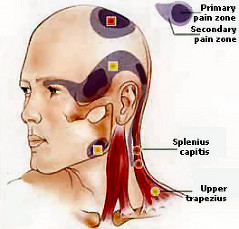Massage: Deep Tissue, Trigger Point Therapy, Myofascial Release, and Neurokinetic Therapy
Our Philosophy and Our Treatments:
Here at Chittenden County Chiropractic, we believe that the musculoskeletal system acts as one entity, and as such, treatment should be aimed at both the muscle tissue and the bony anatomy.

What is Deep Tissue Massage?
Deep tissue massage is a type of massage aimed at the deeper tissue structures of the muscle and fascia, also called connective tissue. Deep tissue massage uses many of the same movements and techniques as Swedish massage, but the pressure will generally be more intense. It is also a more focused type of massage, as the therapist works to release chronic muscle tension or knots (also known as “adhesions.”) Releasing adhesions in the musculature allows the spine and extremity structures to move more “freely” and drastically reduces pain in the symptomatic patient.
What is Trigger Point Therapy?
Trigger point therapy is a more pointed type of massage. Unlike a Swedish or deep tissue massage, trigger point therapy does not include a lot of sweeping motions. The pressure is pointed and held on the point itself until it releases. You may combine trigger point therapy with our other massage modalities. Our massage therapist will work with you to cater a specific plan to your unique needs.

Myofascial Release
Fascia is a thin tissue that covers every organ and muscle in the body giving them form. This fascia can become constricted from overuse or injury and adversely affect the structures it surrounds. Myofascial release is a massage technique that is focused on lengthening and reintegrating fascial tissue and the muscle it surrounds. Myofascial dysfunction has been identified as a key player in chronic injuries, pain patterns, and fibromyalgia. Because the fascia can take some time to stretch and change a one hour session is usually optimal, but smaller areas can be treated in less time.
Schedule An Appointment Today
Schedule an appointment with our Massage Therapists by clicking the button below to schedule online or by calling (802) 879-3900.
Massage FAQ’s
What is a Trigger Point?
Trigger points are described as hyperirritable spots in muscle that are associated with palpable nodules in tight bands of muscle fibers.They usually develop due to a muscular overload and are actually the result of a local area of ischemia (blood loss). The palpable nodules are said to be small contraction knots and are a common cause of pain. Compression of a trigger point may elicit local tenderness, referred pain, or motor dysfunction. Scientists have mapped patterns of referral for trigger points throughout the body. For example, a trigger point palpated in the upper trapezius muscle can cause a referral pattern of pain to the temporal region of the head. Deep tissue massage is highly beneficial in the treatment of trigger points and often times can release trigger points almost instantaneously.
Will A Deep Tissue Massage Hurt?
It shouldn’t hurt, but it’s likely to be a bit more uncomfortable than a classic Swedish massage. You should always feel free to speak up if the pressure is too much for you. Our therapists like to get your feedback. We all have different tolerances to pain, and the only way we know yours, is if you tell us. Generally, patients describe deep tissue work as a “good hurt”.
How Fast Will I Get Results With A Deep Tissue Massage?
Most patients who leave our office experience some level of immediate pain relief. It is however, important to be realistic about what one massage can achieve. Many people ask for more pressure, thinking that if the therapist just pushes hard enough, they can get rid of all their knots in very short period of time. This just won’t happen. In fact, undoing chronic knots and tension built up over a lifetime is best achieved with an integrated program that includes manipulation, exercise, posture restoration, relaxation techniques and a regular program of massage. All of these things considered, we see results much faster with our patient population because of our integrated treatment plan that includes deep tissue massage, hot and cold packs, muscle stimulation, ultrasound and manipulative therapy. Recovery time from injuries and chronic pain is drastically reduced by the use of deep tissue massage.
What Conditions Can Deep Tissue Massage Help?
The answer is many! However, unlike classic massage therapy, which is used for relaxation, deep tissue massage usually focuses on a specific problem, such as:
- Chronic pain
- Headaches
- Limited mobility
- Recovery from injuries (e.g. whiplash, falls, sports injury)
- Repetitive strain injury, such as carpal tunnel syndrome
- Postural problems
- Osteoarthritis pain
- Fibromyalgia
- Muscle tension or spasm
Should I Expect any Side Effects From Deep Tissue Massage?
It is important to understand that some patients may be sore for 24-48 hours after treatment. This is completely normal following deep tissue massage work. Typically, patients who end up sore describe it as a discomfort similar to what we experience following a rigorous workout. Many patients never experience discomfort. Increasing your water intake following deep tissue massage is always a good idea and can reduce your recovery time.
